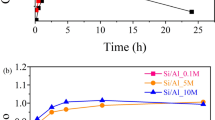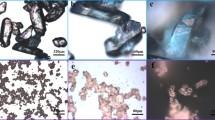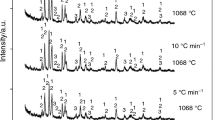Abstract
Decomposition of aqueous solutions of uranyl nitrate in a matrix of granulated silica gel of KSKG grade under the action of microwave radiation (MWR) was studied. Microwave irradiation leads not only to formation of solid decomposition products UO3, UO2(OH)NO3, and their hydrates in pores of KSKG granules, but also to accumulation of gaseous NO x and H2O. The presence of NO x in KSKG pores leads to HNO3 formation in the course of washing of sorbent granules with water. This prevents hydrolysis of uranyl nitrate and formation of UO2(OH)2·H2O in KSKG pores. Washout of uranium with water and HClO4 solutions from the KSKG fraction containing products of decomposition of 2 and 10 g of the initial UO2(NO3)2·6H2O under the action of MWR (hereinafter denoted as KSKG-P-I) was studied. Upon ∼7-day contact of the solid and liquid phases at the total ratio S : L = 1 : 20, from 5 to 14% of U passes into the aqueous phase from KSKG-P-I samples obtained in experiments with 10 and 2 g of UO2(NO3)2·6H2O, respectively. In the course of repeated treatments of KSKG-P-I with water, pH of the wash water increased from 3 to 6, owing to removal of NO x from KSKG pores. Then an insoluble phase of uranyl hydroxide UO2(OH)2·H2O, which can also be presented as hydroxylated uranium trioxide UO3·2H2O, is gradually formed from the solution obtained by treatment of KSKG-P-I with water. On treatment of KSKG-P-I with HClO4 solutions (pH 1–2), virtually all uranium species formed by MWR treatment of aqueous uranyl nitrate solutions in KSKG matrix dissolve (at a contact time of the solid and liquid phases of ∼21 days, the amount of U that passed into HClO4 solutions is ∼90%). The amount of the U form that is not extracted with HClO4 solutions and remains in KSKG granules is ∼12% of its initial amount. X-ray phase analysis suggests that the uranium species remaining in KSKG are silicate compounds formed by sorbent saturation with a uranyl nitrate solution and subsequent MWR treatment.
Similar content being viewed by others
References
Advances in Technologies for the Treatment of Low and Intermediate Level Radioactive Liquid Wastes, IAEA Tech. Rep. Ser., 1994, no. 370.
Poluektov, P.P., Sukhanov, L.P., and Matyunin, Yu.I., Ross. Khim. Zh., 2005, vol. 49, no. 4, pp. 29–41.
Konovalov, E.E., Starkov, O.V., Myshkovskii, M.P., et al., Abstracts of Papers, 3-ya Rossiiskaya konferentsiya po radiokhimii “Radiokhimiya-2000” (3rd Russian Conf. on Radiochemistry “Radiochemistry-2000”), St. Petersburg (Russia), November 28–December 1, 2000, p. 103.
Korchenkin, K.K., Mashkin, A.N., Dzekun, E.G., et al., Abstracts of Papers, 3-ya Rossiiskaya konferentsiya po radiokhimii “Radiokhimiya-2000” (3rd Russian Conf. on Radiochemistry “Radiochemistry-2000“), St. Petersburg (Russia), November 28–December 1, 2000, p. 125.
Moller, M. and Vaiti, R., Atom. Tekh. Rubezhom, 2008, no. 6, pp. 21–24.
Kulyukhin, S.A., Kamenskaya, A.N., and Lavrikov, V.A., Radiokhimiya, 2009, vol. 51, no. 3, pp. 228–233.
Kulyukhin, S.A., Kamenskaya, A.N., and Rumer, I.A., Radiokhimiya, 2009, vol. 51, no. 5, pp. 411–418.
Lidin, R.A., Andreeva, L.L., and Molochko, V.A., Konstanty neorganicheskikh soedinenii: Spravochnik (Constants of Inorganic Compounds: Handbook), Moscow: Drofa, 2006, p. 183.
Lur’e, Yu.Yu., Spravochnik po analiticheskoi khimii (Handbook of Analytical Chemistry), Moscow: Khimiya, 1979, pp. 92–101.
JCPDS—Int. Centre for Diffraction Data, PDF 77-0121, UO2(NO3)2·6H2O.
JCPDS—Int. Centre for Diffraction Data, PDF 16-0204, UO2(OH)(NO3)·3H2O.
JCPDS—Int. Centre for Diffraction Data, PDF 16-0203, UO2(OH)(NO3)·4H2O.
JCPDS—Int. Centre for Diffraction Data, PDF 70-0176, (UO2)2(OH)2(NO3)2·4H2O.
JCPDS—Int. Centre for Diffraction Data, PDF 43-0364, UO3·2H2O.
JCPDS—Int. Centre for Diffraction Data, PDF 29-1376, UO3·2H2O.
Stohl, F.K. and Smith, D.K., Am. Mineral., 1981, vol. 66, pp. 610–625.
Porter, R.A. and Weber, W.J., J. Inorg. Nucl. Chem., 1971, vol. 33, pp. 2443–2449.
Moll, H., Geipel, G., et al., Radiochim. Acta, 1996, vol. 74, pp. 3–7.
JCPDS—Int. Centre for Diffraction Data, PDF 83-2392, (UO2)2(SiO4)·2H2O.
JCPDS—Int. Centre for Diffraction Data, PDF 49-0014, (UO2)2(SiO4)·2.2H2O.
JCPDS—Int. Centre for Diffraction Data, PDF 35-0491, (UO2)2(SiO4)·2H2O.
Author information
Authors and Affiliations
Corresponding author
Additional information
Original Russian Text © S.A. Kulyukhin, A.N. Kamenskaya, 2010, published in Radiokhimiya, 2010, Vol. 52, No. 3, pp. 202–208.
Rights and permissions
About this article
Cite this article
Kulyukhin, S.A., Kamenskaya, A.N. Decomposition of uranyl nitrate in the silica gel matrix under the action of microwave radiation. Radiochemistry 52, 237–244 (2010). https://doi.org/10.1134/S1066362210030033
Received:
Published:
Issue Date:
DOI: https://doi.org/10.1134/S1066362210030033




